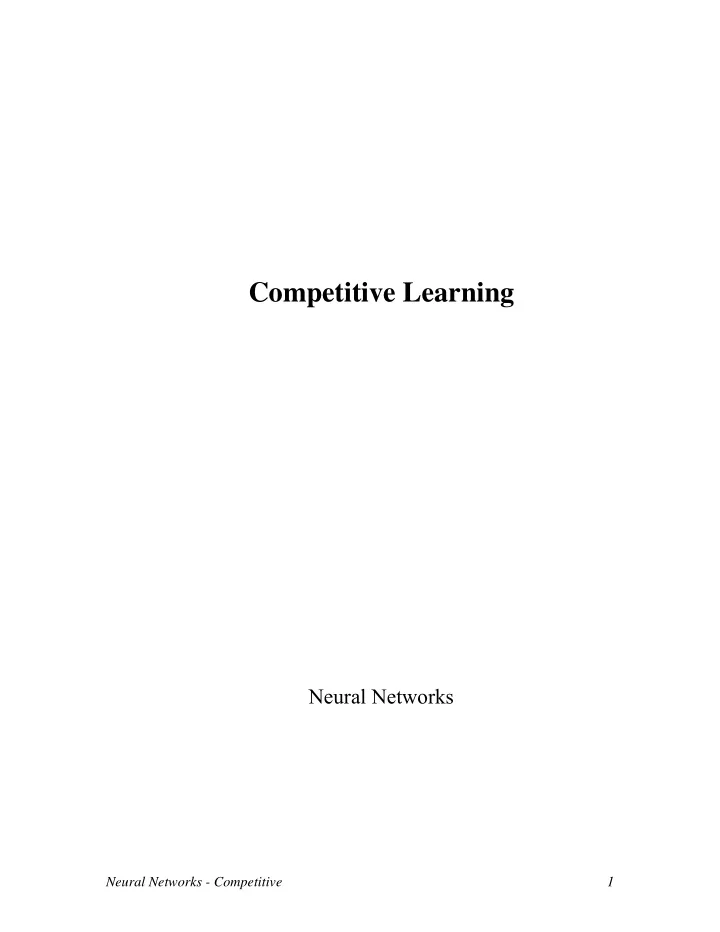

Competitive Learning Neural Networks Neural Networks - Competitive 1
Bibliography Rumelhart, D. E. and McClelland, J. L., Parallel Distributed Processing , MIT Press, 1986. - Chapter 5, pp. 151-193. Kohonen, T., Self-Organization and Associative Memory , Springer-Verlag, 1984. Carpenter, G. and S. Grossberg, A Massively Parallel Architecture for a Self-Organizing Neural Pattern Recognition machine, Computer Vision, Graphics, and Image Processing , 37, 54-115, 1987. Carpenter, G. and S. Grossberg, ART2; Self-organization of stable category recognition codes for analog input patterns, Applied Optics , vol. 26, no. 23, 1987. Carpenter, G. and S. Grossberg, The ART of adaptive Pattern recognition by a self-organizing neural network, Computer , March, 1988. Neural Networks - Competitive 2
Spontaneous Learning Unsupervised Learning No Teacher The system must come up with a spontaneous but reasonable scheme of categorizing patterns Like-to-Like Neural Networks - Competitive 3
Example ART II Classifications Neural Networks - Competitive 4
Supervised and Unsupervised have very different goals Categorization vs Decision Systems Different Target Applications Motor Units Decision System Categorization System Environment Neural Networks - Competitive 5
Competitive Learning Most common scheme for spontaneous learning Relatively simple and intuitive Weight vectors a prototypes assume real weights X 1 w 1 X 2 w 2 Net Z w 3 X 3 w n X n Net most active for pattern similar to weights Neural Networks - Competitive 6
Standard Cluster Diagram Localist Model Neural Networks - Competitive 7
2 prototype example (Lateral Inhibition, Winner take all) 1 2 1 X 2 Y Desired Goal Neural Networks - Competitive 8
How do we reach it from an initial state 2 X 1 Y 1 2 Neural Networks - Competitive 9
Simple Competitive Learning Algorithm Binary Inputs Top nodes winner take all Only winning unit has weights adjusted Each unit as fixed weight ∑ 1, weight is shifted during learning 0 if unit j loses else ⎧ ⎪ ⎨ ∆ w ij = g( s i ⎪ n - w ij ) ⎩ where n is the number of active s i Weight is shifted such that weight vector better matches the current winning input Neural Networks - Competitive 10
Extended models Arbitrary inputs and weights can use a distance metric rather the net Neural Networks - Competitive 11
Simple Unsupervised Learning Model With Distance Metric Initialize n nodes in the attribute dimension space (could be very small n and be constructive) Until Convergence ( ∆ d very small) Input new x Choose node i closest to x (Argmin i (D( n i , x )) Optional: Add new node at x (how to decide?) Move n i slightly closer to x ( ∆ d i = d i + cx i ) ( d is a node dimension and c is a learning rate) Optional: Prune nodes (how to decide?) Neural Networks - Competitive 12
Dynamic Node Growth Y 2 X 1 Y What will happen here vigilance metric for node growth non-global vigilance noisy patterns Neural Networks - Competitive 13
Supervised learning with competitive scheme Simply assign output value to each prototype Basically, multiple prototypes can have the same value 2 1 X 3 4 Y Neural Networks - Competitive 14
Multi-layer net using competitive learning A B 1 2 3 4 Neural Networks - Competitive 15
RCE Learning (Restricted Coulomb Energy) Neural Networks - Competitive 16
ART (Adaptive Resonance Theory) Spontaneous Competitive Learner Dynamic Node Growth Global Vigilance Neural Networks - Competitive 17
Competitive Learning Powerful Intuitive Model Focused applications (Categorizing) Easily extended to supervised models Potential Integration Motor Units Decision System Categorization System Environment Neural Networks - Competitive 18
Recommend
More recommend